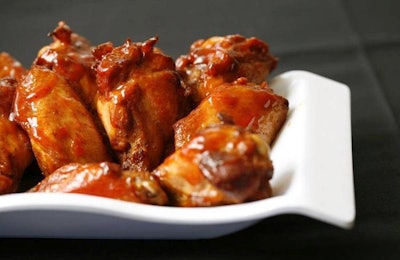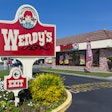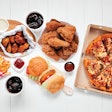
Buyers from three of the fastest-growing foodservice chains and an online retail grocer spoke about managing their chicken purchasing programs at the 2016 National Chicken Council (NCC) Chicken Marketing Summit. Their supply chain challenge is rooted in their success – opening more new stores that sell more chicken per unit than their competitors year after year.
A crowd of about 275 participants at the Chicken Marketing Summit heard that coping with rapid growth in chicken sales is a significant challenge in the buying programs of the three foodservice restaurant chains – Buffalo Wild Wings, Chick-fil-A and Raising Cane’s.
The poultry buyer for online grocer FreshDirect told listeners that obtaining adequate supplies of premium poultry products is a challenge.
All three of the foodservice chains are pure players in chicken with strong growth in system-wide sales, average unit volumes and new store openings. Sales for each of the three concepts are driven by a different chicken part – the wings, the breasts or the tenders.

Chick-fil-A and Raising Cane’s are tops in average unit volumes in the QSR/fast casual category.
FreshDirect – a pure player in the online grocery business with no brick-and-mortar stores – is growing sales in specialty or niche categories in air-chilled, organic, slow-growing and kosher chicken.
Coping with fast-growing chicken sales
The chicken buyers discussed marketing issues – including antibiotic-free chicken – and strategies (current and potential) for keeping up the supply of chicken for their companies’ fast growing sales. Potential growth-coping strategies included:
- Broadening menus to include new/additional chicken parts or other items
- Broadening chicken supplies to include frozen chicken, portioned cuts or international supplies
None of the foodservice buyers foresees sourcing dark meat chicken, except possibly in emergency shortages of white meat chicken or supplying international restaurant operations.
Billion pounds of chicken for Chick-fil-A in 2021?
Mike Ledford, Chick-fil-A’s director of food and beverage sourcing, said the rate of growth in the pounds of chicken purchased and served by the chain for many years ranged between 8 percent and 10 percent but in recent years has accelerated to 20 percent in year-over-year growth.
“At that growth rate, the number of pounds of chicken purchased annually compounds very quickly,” he said. “This year [Chick-fil-A will purchase and serve] around 370 million to 380 million pounds of chicken. If the 20 percent growth rate continues, it would put us close to a billion pounds of chicken by 2021.”
“We spend a lot of time at Chick-fil-A working on plans for how to keep up with that growth. That planning involves our chicken and every single item in our restaurants,” Ledford said. “There is a plan for adding chicken suppliers and processing plants to our portfolio, including the addition of greenfield facilities and conversion of existing plants over to Chick-fil-A specifications.”

Chick-fil-A is on course to purchase 1 billion pounds of chicken in 20121.
Chick-fil-A making "the box" more efficient
Chick-fil-A’s average store sales volume (excluding mall and licensee units) is near the mid $4 million range, Ledford told Chicken Marketing Summit listeners.
“That is actually one of the biggest challenges for Chick-fil-A. The average Chick-fil-A store facility was built for a maximum capacity of $3 million to $3.5 million in sales. So we are constantly looking for ways to make the box more efficient. How can we get customers through there quicker? How can we serve them faster? What can be done in the back of the restaurant to be more lean and efficient and productive? Chick-fil-A has gotten better at these things, but we are going to have to get a lot better if sales continue to increase at present rates.”
Buffalo Wild Wings revenue takes wing
System-wide sales at Buffalo Wild Wings reached $3.6 billion in 2015, and revenue and net earnings continue to show significant growth year after year.

Buffalo Wild Wings unit and sales growth has been outstanding among casual dining chains, approaching that of chains in the QSR and fast casual sector.
Revenue and unit growth at Buffalo Wild Wings, which is in the casual restaurant category, is on par with restaurants in the faster-growing QSR sector. Revenue for the most recent five years grew 24 percent and number of units rose 10 percent at a compounded average rate.
Dean Bradley, director of protein supply, said, “Buffalo Wild Wings has a great growth runway ahead in the U.S. and Canada, as we are at only 70 percent of our goal to open 1,700 restaurants.
“We are always looking five to 10 years ahead to make sure that Buffalo Wild Wings is aligned with suppliers who can handle our volume of chicken wings,” he said.

Buffalo Wild Wings has grown revenue by 24 percent (CAGR) from 2011 to 2015.
Dependable sales lift on chicken wings
Because chicken wings are the mainstay of the Buffalo Wild Wings menu, their popularity with consumers and finite supply frames the supply challenge. The price of chicken wings is highly inelastic, leading to variable and often high input costs. Though wholesale prices are now around $1.60 a pound, prices rose to over $2.60 a pound in the last year.
Bradley told listeners that Buffalo Wild Wings’ response to tight supplies in the chicken wings market won’t be in switching or substituting other products for wings on the menu but in the execution of the basics of its marketing plan. The Buffalo Wild Wings menu already includes boneless wings and other items, including burgers, but the chain’s core menu is wings. “Whenever we promote chicken wings, we see a lift in sales,” he said.
He told Chicken Marketing Summit listeners that Buffalo Wild Wings programs to increase takeout sales and promote against world soccer events are designed to increase market share.
No place at B-Dubs for chicken dark meat
Buffalo Wild Wings, for example, is not considering the addition of chicken dark meat to the menu and probably would not do so. “Probably, Buffalo Wild Wings’ play in chicken dark meat might be in the RTacos (owned by Buffalo Wild Wings) menu and possibly in restaurants outside the U.S.,” Bradley said. Buffalo Wild Wings owns a majority interest in RTacos, a small chain with 15 stores in the U.S., which the company plans to grow to 600 locations in the next 10 years.
Raising Cane’s "one love" is chicken tenders
Since the company’s founding in 1996, Raising Cane’s has opened 308 restaurants where the menu is limited to chicken tender meals. The limited menu hasn’t hindered system-wide sales, which have grown by 29 percent (CAGR) 2011 to 2016 (projected). Sales in 2015 were $750 million.

Raising’s Cane’s has experienced 29 percent CAGR from 2011 to 2016.
The Baton Rouge, Louisianna-based chicken tenders chain, in fact, has made the limited menu its strength. “The limited menu drives throughput at the restaurant locations,” Chris Chang told listeners at the Chicken Marketing Summit.
Unit volume at Raising Cane’s at $2.7 million is second only to Chick-fil-A in the QSR category. Same restaurant sales (SRS) over 30 consecutive quarters are 7.5 percent compared to the 1.6 percent average for the QSR industry.
“At peak restaurant hours a Raising Cane’s kitchen is able to produce a tremendous amount of entrees,” he said. “What can be perceived as a competitive disadvantage – the limited number of menu items – can become an advantage if there is enough demand, and this is what we are able to do.”
Asked if Raising Cane’s might broaden the menu, Chang said, “We try to not get distracted with innovating our menu at the same time we are trying to expand geographically both domestically and internationally.”
The number of Raising Cane’s restaurants has risen from 119 in 2011 to 308 in 2016. The company’s plans include raising the number of restaurants to 600 and sales to $1.5 billion.
“Raising Cane’s has a tremendous opportunity for menu expansion,” Chang continued. “The first opportunity would be to open for breakfast, and we can easily add a desert to the menu.”
Planning future supplies of chicken tenders
Raising Cane’s currently purchases 100 percent natural fall tenders in the 46- to 65-gram range, but the company is evaluating alternative supplies for continued growth. Pilots are under way for the supply of trimmed, portioned, marinated tenders. The company currently marinates all of its tenders in-house.
Future supplies of tenders might also include frozen tenders (currently all supplies are fresh) and internationally sourced supplies. Adding breast meat to the menu is also under consideration.
Online grocery is opportunity in premium poultry
FreshDirect estimates it has 41 percent market share in the online grocery business in New York with Peapod its closest rival at 23 percent. The online grocer focuses on differentiating itself by having a better supply chain to offer greater variety of fresher sustainable products.

FreshDirect has an estimated 41 percent of online grocery sales in the New York City market area.
“FreshDirect offers extreme breadth and depth in its product assortment,” said Stefan Oellinger, the company’s category merchant for sourcing of meat and poultry.
“We offer everything from conventional chicken to ultra-premium air-chilled organic chicken, which is humanely harvested. Every attribute that you can throw at it the customers will buy,” he said.
Oellinger said the online grocery business brings greater opportunity for marketing and sales of premium poultry products. “There is more sales and marketing opportunity at the high end,” he said.
Differentiation in product variety continues to produce incremental sales at FreshDirect, he noted.
“Our fastest growing category now is kosher organic chicken. Many buyers – not traditional kosher buyers – simply perceive it as being higher quality or cleaner or better,” he said.
“There is a lot of opportunity to promote chicken without necessarily promoting based on price,” he said.
PURE PLAYS IN CHICKEN GROWING FAST
Growth in restaurant store units, average unit volumes and company-wide sales for these three foodservice chains rank near the top for their respective concepts:
WINGS – Buffalo Wild Wings, the casual dining chain, which focuses on “Wings. Beer. Sports.” at 1,190 restaurants around the world, saw 9 percent growth in number of units, 3 percent growth in average unit volumes and 11 percent growth in system-wide sales in 2015.
BREASTS – Chick-fil-A, the inventor of the chicken breast sandwich, is the fifth fastest-growing restaurant chain in the U.S. with system-wide sales rising around 18 percent to over $6 billion. Nation’s Restaurant News estimates average unit volume at the over 2,000 Chick-fil-A locations rose by nearly 12 percent in 2015 to more than $3.5 million – tops among all limited service restaurants and over twice the average of $1.5 million.
TENDERS – Raising Cane’s “one love,” chicken finger meals, is powering system-wide sales in 2016 to a projected $753 million, capping a 7.5 percent rate of growth over the past 30 quarters. The chain’s average unit sales volume of $2.7 million is second to only to that of Chick-fil-A.
PREMIUM CHICKEN – FreshDirect serves the $80 billion foodie marketplace in New York City and Long Island; Westchester, Connecticut; and metropolitan Philadelphia. All orders are picked form the warehouse inventory and trucked directly to the consumer. With sales estimated between $400 million and $500 million, FreshDirect is constructing facilities that will triple its warehousing space.
2017 Chicken Marketing Summit
The 2017 Chicken Marketing Summit is scheduled for July 16-18 at the Omni Grove Park Inn, Asheville, North Carolina. To learn more, go to www.WATTGlobalMedia.com/ChickenMarketingSummit.
















